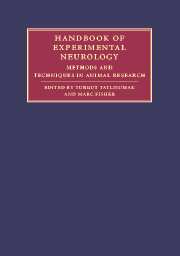Book contents
- Frontmatter
- Contents
- List of contributors
- Part I Principles and general methods
- 1 Introduction: Animal modeling – a precious tool for developing remedies to neurological diseases
- 2 Ethical issues, welfare laws, and regulations
- 3 Housing, feeding, and maintenance of rodents
- 4 Identification of individual animals
- 5 Analgesia, anesthesia, and postoperative care in laboratory animals
- 6 Euthanasia in small animals
- 7 Various surgical procedures in rodents
- 8 Genetically engineered animals
- 9 Imaging in experimental neurology
- 10 Safety in animal facilities
- 11 Behavioral testing in small-animal models: ischemic stroke
- 12 Methods for analyzing brain tissue
- 13 Targeting molecular constructs of cellular function and injury through in vitro and in vivo experimental models
- 14 Neuroimmunology and immune-related neuropathologies
- 15 Animal models of sex differences in non-reproductive brain functions
- 16 The ependymal route for central nervous system gene therapy
- 17 Neural transplantation
- Part II Experimental models of major neurological diseases
- Index
- References
14 - Neuroimmunology and immune-related neuropathologies
Published online by Cambridge University Press: 04 November 2009
- Frontmatter
- Contents
- List of contributors
- Part I Principles and general methods
- 1 Introduction: Animal modeling – a precious tool for developing remedies to neurological diseases
- 2 Ethical issues, welfare laws, and regulations
- 3 Housing, feeding, and maintenance of rodents
- 4 Identification of individual animals
- 5 Analgesia, anesthesia, and postoperative care in laboratory animals
- 6 Euthanasia in small animals
- 7 Various surgical procedures in rodents
- 8 Genetically engineered animals
- 9 Imaging in experimental neurology
- 10 Safety in animal facilities
- 11 Behavioral testing in small-animal models: ischemic stroke
- 12 Methods for analyzing brain tissue
- 13 Targeting molecular constructs of cellular function and injury through in vitro and in vivo experimental models
- 14 Neuroimmunology and immune-related neuropathologies
- 15 Animal models of sex differences in non-reproductive brain functions
- 16 The ependymal route for central nervous system gene therapy
- 17 Neural transplantation
- Part II Experimental models of major neurological diseases
- Index
- References
Summary
Basic immunology
Systemic immunology
Immunology is a relatively new and rapidly developing field that is involved in most clinical diseases. In 1796, Edward Jenner discovered that cowpox or vaccinia induced protection against human smallpox, but he knew nothing of the infectious agents that cause disease. Late in the nineteenth century, Robert Koch proved that infectious diseases are caused by microorganisms. We now recognize four broad categories of disease-causing microorganisms or pathogens: viruses, bacteria, fungi, and parasites. In 1890, Emil von Behring and Shibasaburo Kitasato discovered that the serum of vaccinated individuals contained antibodies that specifically bound to the relevant pathogen. Both innate and adaptive immune responses depend on the activities of leukocytes.
The immune system is a complex network of specialized cells and organs that defend the body against foreign pathogens and maintain the balance between immunity and tolerance. The peripheral lymphoid organs (lymph node and spleen) are specialized to trap antigen and allow the initiation of adaptive immune responses. Once lymphocytes are mature, they leave the central lymphoid organs (thymus and bone marrow), and are capable of responding to foreign pathogens. Peripheral mature immune cells include lymphocytes (T cells and B cells), antigen presenting cells (macrophages and dendritic cells, DC) and nature killer (NK) cells. Armed effector T cells play a critical role in almost all adaptive immune responses. Both major histocompatibility complex (MHC) and co-stimulatory signals provided by professional antigen-presenting cells (APC) are required for the activation and expansion of T cells.
- Type
- Chapter
- Information
- Handbook of Experimental NeurologyMethods and Techniques in Animal Research, pp. 212 - 238Publisher: Cambridge University PressPrint publication year: 2006



